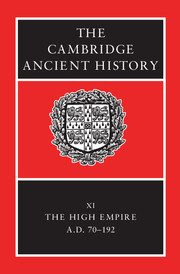Book contents
- Frontmatter
- PART I NARRATIVE
- PART II GOVERNMENT AND CIVIL ADMINISTRATION
- PART III THE EMPIRE
- PART IV ROME, ITALY AND THE PROVINCES
- PART Va ECONOMY AND SOCIETY
- 23 The land
- 24 Trade
- 25 Industry and technology
- 26 Commerce and finance
- 27 Demography
- 28 Status and patronage
- 29 Family and household
- PART Vb ART AND CULTURE
- Chronological Table
- BIBLIOGRAPHY
- Index
- 1 The Roman world in the time of Marcus Aurelius
- 7 The Danube provinces
- References
24 - Trade
from PART Va - ECONOMY AND SOCIETY
Published online by Cambridge University Press: 28 March 2008
- Frontmatter
- PART I NARRATIVE
- PART II GOVERNMENT AND CIVIL ADMINISTRATION
- PART III THE EMPIRE
- PART IV ROME, ITALY AND THE PROVINCES
- PART Va ECONOMY AND SOCIETY
- 23 The land
- 24 Trade
- 25 Industry and technology
- 26 Commerce and finance
- 27 Demography
- 28 Status and patronage
- 29 Family and household
- PART Vb ART AND CULTURE
- Chronological Table
- BIBLIOGRAPHY
- Index
- 1 The Roman world in the time of Marcus Aurelius
- 7 The Danube provinces
- References
Summary
INTRODUCTION
All forms of market exchange fall within the scope of this chapter, including everything from local trade in which very little transport of goods might be involved to trade over long distances, both inside and outside the Roman empire. We shall also need to take into consideration some transfers of goods which took place outside the market. The main commodity so distributed was the grain which, having come into the government's hands partly as provincial tribute, was shipped to Rome and divided gratis among the recipients of the corn dole. The Roman empire knew many other types of governmental and private largess; indeed, taken together they play an essential role in the social system. We shall also notice other ways in which the imperial government and city governments were involved in commercial activities. Trade is defined here as exchange of goods in which a desire for profit is the motive of one party or both; we shall be especially concerned with trade taking place over considerable distances, at least from one city's territory to the next.
One question we have to face is simply whether trade was very important. The question has commonly been presented as a crude dichotomy: either trade was mainly a matter of ‘luxuries’ and special cases, a relatively minor by-product of an agrarian economy which had few of the modalities of more vigorous pre-industrial economies, or the Romans developed an intense commercial system which had effects on large segments of the population and rivalled in scale the most commercial economies which ever existed before the twentieth century.
Keywords
- Type
- Chapter
- Information
- The Cambridge Ancient History , pp. 710 - 740Publisher: Cambridge University PressPrint publication year: 2000
References
- 12
- Cited by

